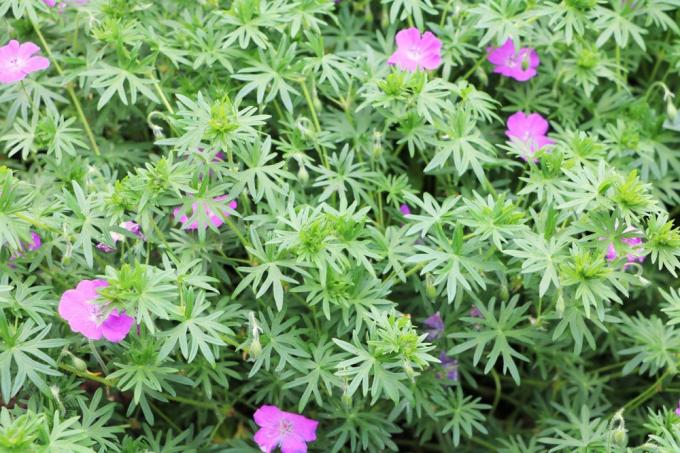
table of contents
- Characteristics
- Location
- Soil / substrate
- sowing
- Planting
- Fertilize
- to water
- Transplanting
- Cut
- Overwinter
- Multiplication
- Diseases and pests
Profile and care information open +conclude -
- Flower color
- pink, purple, white, blue
- Location
- Shade, partial shade, sunny
- Heyday
- March, April, May, June, July, August, September, October
- Growth habit
- upright, bushy, flat-growing, clump-forming, perennial
- height
- up to 1 m high
- Soil type
- loamy
- Soil moisture
- moderately moist
- PH value
- neutral, weakly alkaline
- Limescale tolerance
- Calcium tolerant
- humus
- rich in humus
- Poisonous
- no
- Plant families
- Cranesbill Family, Geraniaceae
- Plant species
- Ground cover, medicinal plants, perennials, meadow flowers
- Garden style
- Cottage garden, flower garden, natural garden, rock garden
The cranesbill is a particularly popular garden plant, of which there are around 400 different species. The plant is characterized by its attractive foliage and beautiful flowers that bloom from March to October. Not to be forgotten are its decorative fruit stands, which also decorate the garden. As beautiful as the cranesbill is, it is also easy to care for. Because from sowing to wintering, the popular perennial does not require a green thumb and can also be cultivated by beginners without any problems.
Characteristics
- Plant family: cranesbill family (Geraniaceae)
- Flower color: mainly blue-violet
- Flowering period: March to October
- Height: 15 cm to 1 m
- Growth habit: different (perennials, ground cover)
- toxic: no
- hardy: most varieties yes
- Location: different, depending on the species
- perennial: yes
Location

The cranesbill grows particularly well on the edges of trees and is ideal as a companion plant for taller perennials, such as shrub roses. Most species prefer a moderately humid spot that is ideally sunny. Regardless of the location, the necessary planting distance must always be taken into account:
- Plant spacing: 20 - 40 cm
- depending on the height and width of the respective variety
- Either 8-10 large or 12-16 small plants per m²
While certain location requirements for the cranesbill can be generalized, the optimal location ultimately depends on the respective cranesbill species. Because depending on the species, the plant has different requirements for the respective location. The advantage here is that the right species is available for every garden:
Sunny and humid
- Basque cranesbill (Geranium endressii)
- Himalayan cranesbill (Geranium himalayense)
- Splendid cranesbill (Geranium magnificum)
- Meadow cranesbill (Geranium pratense)
- Black-eyed cranesbill (Geranium psilostemon)
Sunny and dry
- Crimson cranesbill (Geranium sanguineum)
- Caucasus cranesbill (Geranium renardii)
- Cambridge cranesbill (Geranium cantabrigiense)
- Gray cranesbill (Geranium cinereum)
Partially shaded and moist
- Geranium gracile
- Himalayan cranesbill (Geranium himalayense)
- Forest cranesbill (Geranium sylvaticum)
Shady and dry
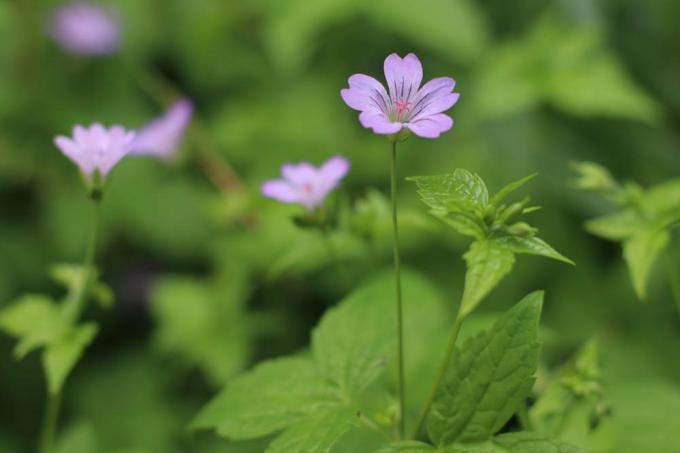
- Balkan cranesbill (Geranium macrorrhizum)
- Gnarled cranesbill (Geranium nodosum)
- Brown cranesbill (Geranium phaeum)
Soil / substrate
In general, it can be said that the cork's bill can handle most garden soils. If necessary, the soil can be improved and optimized for the plant before planting. For this purpose, heavy, moist soils are enriched with gravel or sand. This gives the soil a coarse structure, which in turn improves ventilation and water drainage. Acid soils are improved by means of liming. The floor does not generally need to be improved if it has the following properties:
- wet
- humus
- nutritious
- permeable
- high proportion of lime
sowing
In order to sow cranesbills yourself, seeds are first needed. These can easily be collected from existing plants. The right time is important here, because the seeds must not be collected either too early or too late. Green seeds are not yet ready to germinate, which is why it is better to wait. But not for too long, otherwise there is only an empty shell left. You can tell whether the seeds are ripe by the fact that the fruit pops up quickly when touched. The seeds are then sown in March / April and cultivated on the windowsill:
- Fill the seed tray with a mixture of sand and earth
- Put seeds in with enough space between them
- Cover the seeds with some soil
- Keep the substrate evenly moist
- Cover the seed tray with foil
- high humidity promotes germination
- Place the seed tray in a bright, warm place
It is worth mentioning that the seeds usually sprout very irregularly. While some seeds germinate particularly quickly, others take significantly longer. Give the seedlings sufficient time to flourish and wait for them to form the third leaf. Because this is the ideal time to prick out the seedlings.
Note: The cranesbill usually only blooms in the second year.
Planting
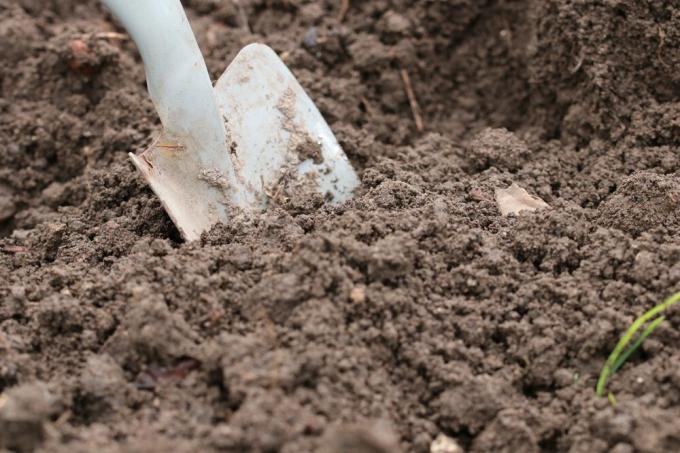
Before the young plants are set in the field, the ideal location should first be found. In addition to the optimal conditions, the appearance of the plants must also be taken into account. It is therefore advisable to plant higher-growing species in the background, whereas smaller specimens are allowed to be in the front. After the location has been selected, the first step is to prepare the ground. To do this, loosen the soil properly and remove weeds. Because the fewer weeds there are, the easier it is to plant:
- Put the root ball in a bucket full of water
- Roots should soak up properly
- leave in it until no more air bubbles rise
- Dig out the planting hole, about twice the size of the root ball
- Place plants in the middle
- water well after planting
Note: Cranesbills can generally be planted all year round, provided the ground is not frozen. However, if these are grown as ground cover, wait until late summer or spring. Because at this time, the growth of weeds subsides again.
Fertilize
When it comes to fertilizing, the cork's bill is very frugal, because it needs a start-up fertilization, especially in the spring after budding. It is best to use a liquid complete fertilizer or a perennial fertilizer. It is important that the correct amount is always used and that it is not overdosed! Alternatively, compost is also recommended as a fertilizer.
- fertilize regularly after starting fertilization
- until the end of July until the beginning of August
- fertilize every 2-4 weeks
- preferably with compost
Note: The last fertilization generally takes place in August so that the plant can calmly prepare for winter dormancy.
to water
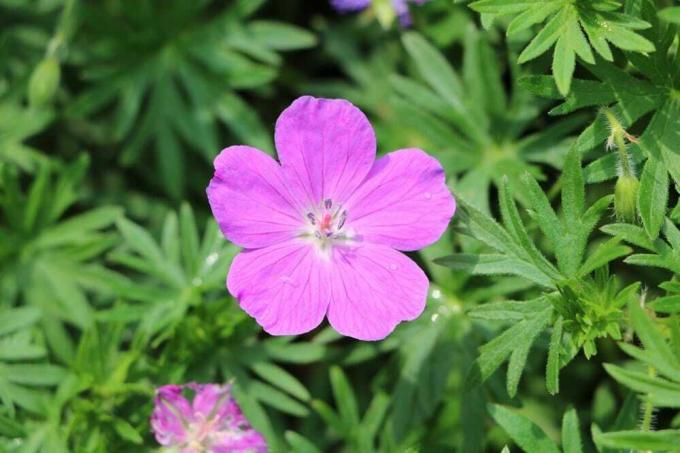
As soon as the cranesbill has grown, it practically takes care of itself. The situation is different with freshly planted specimens, because they still need a little support until they grow and should be regularly supplied with water. The same also applies to storks' beaks kept in the bucket.
- Water only if it is long-term dry
- too much moisture promotes rot on rhizomes
- Waterlogging is not well tolerated
- Do not let the plant dry out!
- water early in the morning or late in the evening if necessary
Note: It is quite possible that the cranesbill will hang the leaves in summer. However, this is not directly a cause for concern, as the plant often recovers after the rain.
Transplanting
Sometimes it may be necessary to transplant the cranesbill. Most species do just fine with transplanting. Only those species that form very long tap roots could have problems with this care measure. If you want to move the perennial, you should choose a mild day in April or May or in August or September. The best way to move the plant to the new location is as follows:
- Carefully dig up the plant
- dig up as much root volume as possible
- cut roots too long
- Insert the plant directly in the new location
- preferably without a long delay
- Plant depth the same as before
- water sufficiently
Note: The more root volume that is retained when digging out, the higher the chances of success of transplanting!
Cut

It is not absolutely necessary to cut the cranesbill, but it is still highly recommended. In particular, stork beaks that are not evergreen and clumpy will benefit from pruning. Because the care measure promotes new growth and can also cause a second flowering in late summer.
- cut back all shoots in autumn
- down to a few centimeters
- Cut / shorten the ground cover in autumn or spring
- Cut back can be left
- offers good frustration protection
Overwinter
The cranesbill is generally considered perennial and hardy, with most species tolerating temperatures down to minus 15 degrees Celsius without any problems. Some species are even evergreen and keep their handsome foliage even in the cold season. It is therefore generally not necessary to protect the cranesbill from frost. However, frost protection is recommended if the plant is cultivated in a pot.
- hardy to -15 degrees Celsius
- Frost protection outdoors is not required
- If possible, leave the leaves until spring
- Protect potted plants from frost
- Cover the pot with bubble wrap, jute or felt
- Place the pot on a cold-insulating surface (wood or styrofoam)
Note: If you want to protect outdoor plants from frost for safety, you can simply pile them up in the root area. Leaves, straw, brushwood or compost are suitable for this.
Multiplication
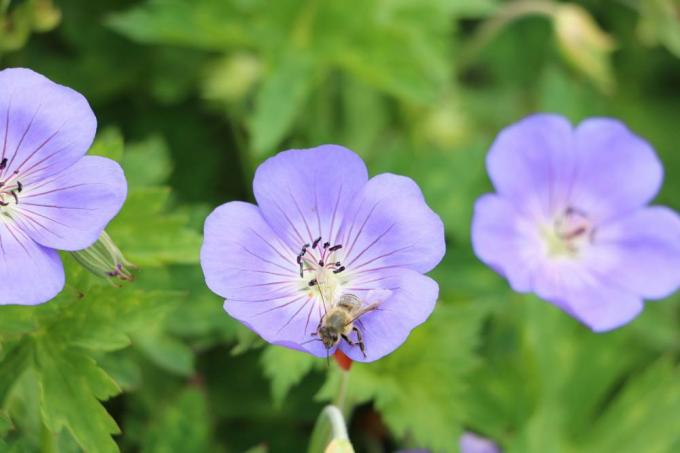
On the one hand, there is the possibility of propagating the cranesbill using seeds. For this purpose, the seeds are collected in spring and then cultivated on the windowsill. Alternatively, the geranium can also be propagated using rhizome cuttings or head cuttings.
Rhizome cuttings: Divide the cranesbill
This method is particularly suitable for clumpy cranesbill species. The best time for dividing is in spring, but the cranesbill can be divided during the entire vegetation phase - from May to the end of August. The best way to divide the cranesbill is as follows:
- Carefully dig out the root ball
- cut off part of the excavated plant
- cut off a maximum of 1/3
- take one or more pieces of root about 5 cm long
- Cut off the roots straight at the top and at an angle at the bottom
- Dig in the roots with the sloping side down
- do not insert it too deeply, preferably close to the ground
- either in pots or outdoors
- water regularly
- The first shoots usually appear after 4 - 6 weeks
Head cuttings
Propagation using head cuttings is also possible, also during the entire vegetation period (May to August). For this purpose, some head cuttings are taken from the cork's bill, whereby these should be strong, healthy and not lignified. Then all buds, flowers and leaves are removed so that only three pairs of leaves remain. The cuttings are now placed in a pot and cared for as follows:
- Place cuttings in a bright and warm place
- full sun windowsill is ideal
- fertilize after 4 - 6 weeks
- Plant out cuttings in spring
Diseases and pests
Cork's beaks are generally considered to be very robust, so that neither diseases nor pests pose a great threat to the crop. The plant is also fundamentally of no interest to snails. However, certain diseases and pests cannot be completely ruled out. Under certain circumstances, the cranesbill can therefore struggle with the following difficulties:
- Wrong mildew
- Rust fungi
- Small leaves


